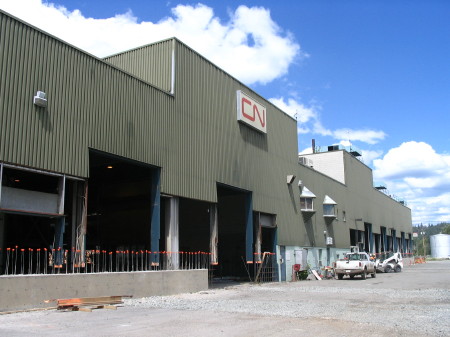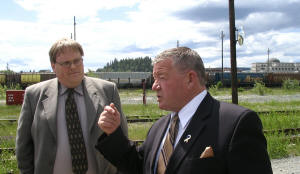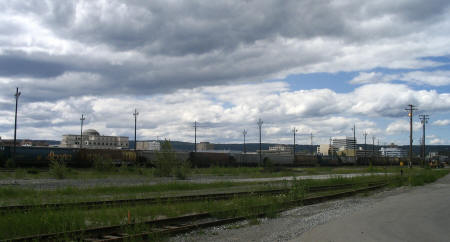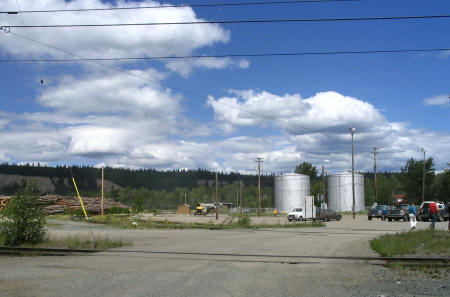Work Underway At CN For Inland Container Port

CN’s car shop has been completely gutted inside, it will be the ICP’s warehouse
The first on-site look at the $20-million dollar project underway to convert CN’s First Avenue rail yard in Prince George into an Inland Container Port leaves much to the imagination, but those on-hand from the City, Initiatives Prince George and Canadian National believe the facility will open up limitless possibilities.
Mayor Colin Kinsley says, "There’s hype over ’Oh, what will this mean?’ and ’Isn’t this great’ and yada, yada, but the true measure of this in my view, and I’m looking out several years, this is the first stage - having a trans-load and inter-modal facility here in Prince George - that’s going to lead to Prince George being the transportation and distribution hub for North America."
Kinsley says the region is the bread-basket for natural resources, now the cheaper transportation and access to foreign markets is coming in, and, he believes, a manufacturing industry will follow.
Initiatives Prince George Director, Clint Dahl, agrees. "The investment that CN is putting into our community is a great platform to launch, basically, an entirely new industry as Colin talked about."
 CN’s General Manager for the Mountain Region, Tom Bourgonje (shown at left with Mayor Colin Kinsley) says the inland container port will be ready for business on October 1st.
CN’s General Manager for the Mountain Region, Tom Bourgonje (shown at left with Mayor Colin Kinsley) says the inland container port will be ready for business on October 1st.
"We’re in the process of hiring staff to work in this facility here, we’re in the process of hiring conductors to run the additional trains, so, all told, that nets out to about 60 people."
Bourgonje says, initially, there will be two 12,000-foot trains running, one in each direction, but that could be upped to two in each direction depending on the demand.
 The picture at right shows the future site of the intermodal pad. There will be one 2400-foot inter-modal track in one direction and across the pad, another 2400-foot track, where the containers will be loaded and un-loaded.
The picture at right shows the future site of the intermodal pad. There will be one 2400-foot inter-modal track in one direction and across the pad, another 2400-foot track, where the containers will be loaded and un-loaded.
Bourgonje says the track could be extended the entire length of the railway yard in the future if the demand was there.
The intermodal pad lies to the south of the warehouse building, towards First Avenue.
The former car shop will soon be home to office space, the trans-load and warehousing operation, with 17 docks for trucks rolling in and out of the area.
 And the existing parking lot, off River Road, will have tracks running through it for a lumber re-load area.
And the existing parking lot, off River Road, will have tracks running through it for a lumber re-load area.
Bourgonje says, "We see this as a huge opportunity for Northern BC in terms of turning this into a major transportation corridor between Prince Rupert and Prince George, Northern BC, on to Edmonton, on to Chicago and other destinations."
"We certainly see the potential for business. I don’t think anyone realizes the potential of what that business is yet, but I think it’s huge."
Previous Story - Next Story
Return to Home











(1) Anyone remember the BC Rail Intermodal. It was shut down a few years ago as a prelude to selling BC Rail to CN Rail. 85 people lost their jobs as a result.
(2) Kinsley says that the region is the bread basket for natural resources, now that cheaper transportation and access to foreign markets is coming in. Where does he think the natural resources from (a) Bell Copper Topley and (b) Gransile Copper Topley went to for the 15 years that they were in operation. (c) Endako mines have been in operation for over 20 years. (molydenum) how do you think that was shpped. (d) Kemess has been in operation for over 10 years (e) Dont forget the two huge coal mines in Tumbler Ridge that operated for 15 years. Bullmoose and Quintette this traffic moved through Prince George to Prince Rupert for export. I could mention more but you get the point.
Its good to see that this operation will employ approx 60 people, that will just about replace the number of people who lost their jobs as a result of CN buying BC Rail.
One 12000ft (2 Mile) train in each direction. These trains are run by (1) Engineer and (1) Trainmen for each train, and I beleive that they will run from Prince George to Jasper and Return and Prince George to Smithers and Return.
Kinsley says that this could lead to Prince George becoming the Transportation and Distribution Hub for North America. Duhhhh?
Lets put this in context, using the Belt Railway Co., of Chicago Ill. as an example.
The Belt Railway is the largest intermediate switching terminal railroad in the United States, employing approximately 520 people. The Belt has 28 Miles of mainline route with more that 300 miles of switching tracks, allowing it to interchange with every railroad serving the Chicago rail hub. The Belts Clearing yards span a 5.5 mile distance among 786 acres, supporting more than 250 miles of track. The Belt Railway currently dispatches on a service-driven basis more than 8400 rail cars per day. At the clearing yards employees are able to classify between 40 and 50 miles of train consist every 24 hours.
For those who might be interested 8400 cars per day is approx 34 times as many as the CN Rails present project of 1 train per day in each direction.
To suggest that Prince George will be a transportation and distribution hub for North America is ludicrous.
You can sum the whole article up by the statement from the CN dude who doesnt seem to realize that Prince George has been the Transportation Corridor from Prince Rupert to Edmonton and Pr George North and South for years. Adding one train a day in each direction which will not even replace the coal trains that we had a few years ago will hardly make us a Transportation Hub.
They see the potential for business, they dont know what that potential will be, but it will be huge. Duhhh?